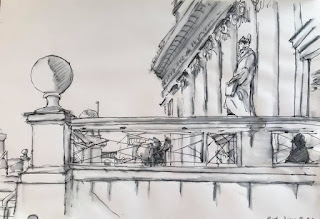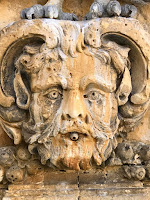Three strong impressions from the day….
One, that we misread the mapping from the phones, compounded by the very unfamiliar place names. We had planned to get the little ferry into Valletta from suburb/outlier of the community of Sliema - just for the fun of it. Inadvertently we drove into Valletta itself, found a parking place far far along the rough track by the sea under the fortifications, and jumped on the ferry only to find ourselves on the wrong side of the water and not in Valletta at all! I report this because it shows how easily one can believe one’s own assumptions: I thought we were in Sliema, when the mapping clearly showed the directions (N/S) were all the wrong way round and still I didn’t twig. Not till the lady in the Tourist Info at Sliema told us, did we understand. She said there was nothing to see in Sliema - just shopping malls and commercial buildings. We saw Mothercare (closed now in the UK), M&S, Accessorize, HSBC, Matalan, etc etc, none of which were of any interest to us. The quayside is clean and tidy, and being upgraded to provide smoother and swifter passenger experience for those embarking on the various tourist and ferry boats.
Two: that Valletta is a really lovely place to be. The grid-pattern of streets up and down over the great ridge is surrounded by massive fortifications around the sea wall, and with at least a few quaint place-names reassuring to a Brit abroad - Old Bakery Street, Merchants Street, Windmill, etc.
The architecture is really interesting, with great examples from all the preceding centuries, and lots of swagger. There are humble artisan dwellings, palazzos, statuary, balconies, churches, greater and lesser squares, dark alleys, a comfortable international atmosphere, lots of cafes with all the benefits of the Italian cuisine, and (oh dear) that comforting British smattering of signs and telephone boxes. We felt at home. I particularly liked the tradition of the decoration on the corners of buildings, looking like piles of sandwiches.
We strolled about, found lunch (Maltese rabbit stew for milord, and meagre fish for me). I had forgotten that Samuel Taylor Coleridge came to live here (1804/5) and later a friend prompted me to seek out the Carravaggio paintings. We will go back before we leave Malta to find them. The whole city - like the whole island - represents the full history of Europe, and the present crisis (coronavirus, supremacy of fascism/banking culture, digital take-over of old ways of doing things). And, this could be one of the most fortified cities in Europe too, with fortresses and barracks and towers and huge walls dominating every part of the scenery, especially at the waterfront. Collecting our car, we laughed at the huge rocky potholes which create a kind of terrible game for any drivers who’ve crept down there, past the old fishermen’s dock, and round the headland facing into the easterly winds.


Three: I wanted to get into the National Museum of Archaeology to better understand the Neolithic and maybe Bronze Age history of Malta, and I found it so overwhelming that I can scarcely begin to describe its treasures. I had heard of the Fat Ladies of Malta, but had no idea of how many there are, or how fat. Over the past few years, I have built up a small collection of replica ‘goddesses’ from Greece, the Cyclades, the Canary Islands, the Balearic Islands, Spain, France, Germany, the Balkans, Turkey, Afghanistan, India, etc etc., and developed a sense of how widespread and ‘ordinary’ or humdrum these little figures often were. To me they were at least partly some kind of talisman against the perils of childbirth, and a celebration of sex and fertility, and the idea of the earth as a female thing. Adorned with or accompanied by spirals, archways, sometimes stars and those ‘hooked diamonds’, they had a universality, and their placement in locations such as Newgrange with its solstice alignments showed how informed the people of the late Ice Age were. They all come from a time long before writing of any kind, and indeed before weapons were even thought of. Along with scrapers and hooks and needles, they were just part of the toolkits needed to survive, spiritual spanners, personal portraits.
But the Maltese ‘Ladies’ are so remarkable even in their fragmentary condition, they outshine most of the rest. They celebrate a colossal corpulence. They do seem to be female (though one note says they may also include males… I didn’t see that, but still….). For some reason, vast oozing fatness was an important aspect - at least for some time. Some of the figurines are just female and not fat. One at least has nine little marks on its back, perhaps counting the months of pregnancy. Many have the triangular delineations of the pubic area. Some are headless, or seem to be made to have different heads attached to them. Some were found beside or on top of blocks of stone decorated with spirals or interlacing circular C-shaped whorls. But mostly, staggeringly, they were fat. Were these fat women depictions of Mother Earth? Of a goddess? Of priestesses? We don’t know. So much of the archaeology was done in the 1920s - clumsy and inadequate we think now, in the face of more recent technical methods of analysis. But it was all pre-writing - so there are no records, or even myths or legends. The people who made the temples and carvings and clay figurines seem to have come to Malta from Sicily, and they were farmers. There was a long gap before the Bronze Age people arrived - and nothing to explain why the Stone Age people disappeared…. they don’t seem to have been the same people. The Bronze Age brought weapons, and male deities… the old mothering earth cults just faded away into nothing. I felt overwhelmed by all this, what it could all mean, and calmed myself by doing some drawings - very quick - of some of the exhibits.

In the Museum, they have banned cash exchanges (cards only), and no audio guides, because of the virus. So I may have missed a lot of information which has been gleaned since the quite wordy information boards beside the exhibits. I bought three more replica ‘goddesses’, of poor quality but at least attempting to describe the shapes of the females found in the stony fields between the wars. There is also a repro model of the cart-ruts which have baffled historians, and which we failed to find on Day 1, with a very good video made by British archaeologist Dr David Trump who seems to have devoted his life to the treasures of the island. Seeing him wipes away a lot of the pain and misery inflicted by his namesake. There are good Trumps, too.
At the supermarket back at Mellieha, there was pandemonium. Whereas the day before it had all been quiet and orderly, we found it heaving with people with trollies and baskets overflowing. The queues stretched right through the store. Apparently the government has announced the closure of all schools, so that set everyone off into sensible/panic mode. It took us nearly 25 minutes of queueing to buy a loaf and a bar of chocolate. Eheu!





























































